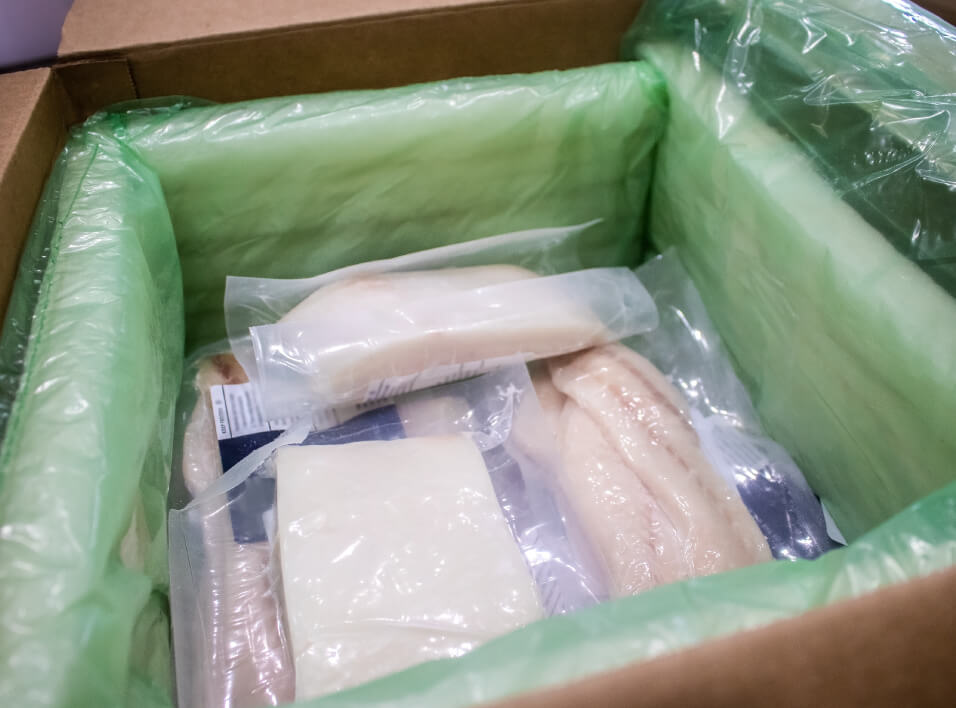Dry Ice Packs for Shipping: Keeping Your Perishables Fresh and Safe
Transporting perishable items like food and pharmaceuticals presents unique challenges for the distribution industry. Maintaining the right temperature throughout transit is crucial to ensuring the quality, safety and integrity of these products. Dry Ice packs are a reliable and efficient solution for Temperature Controlled Product Distribution. In this article, we explore how Dry Ice packs work, their benefits, applications, and best practices to employ when using them.
What Are Dry Ice Packs?
Dry Ice packs are containers or packaging filled with Dry Ice, a solid form of carbon dioxide (CO₂). Dry Ice sublimates at -78.5°C, transitioning directly from solid to gas without becoming liquid. This unique property makes Dry Ice a clean and effective cooling agent for maintaining low temperatures during transit.
How Do Dry Ice Packs Work?
Sublimation and Cooling
Dry Ice sublimates into CO₂ gas when it absorbs heat. Dry Ice packs draw in heat from the surrounding environment, providing a consistent cooling effect. As a result, Dry Ice packs can maintain extremely low temperatures for extended periods, making them an ideal solution for shipping perishable goods over long distances.
Insulation and Containment
Dry Ice packs are typically used in combination with fit-for-purpose, insulated shipping containers. These containers minimise heat transfer from the external environment and prolong the cooling effect of the Dry Ice. Proper insulation ensures that the temperature inside the package remains stable throughout the journey. This cost-effective method for temperature-controlled shipping removes the need for refrigerated vans or lorries.
Advantages of Using Dry Ice Packs
Extended Cooling Duration
One of the main advantages of Dry Ice packs is their ability to maintain extremely low temperatures for long periods. Unlike gel packs or water-based ice, Dry Ice doesn’t melt, rather, it sublimates from a solid to a gas avoiding the risk of liquid or moisture damaging your goods and products. Dry Ice is an exceptional material for long-distance shipping and cooling perishables that require ultra-low temperatures.
Non-toxic and Environmentally Friendly
Dry Ice sublimates into carbon dioxide gas, leaving no liquid residue or toxic by-products. It’s a natural and environmentally friendly cooling agent that is also cost-effective when compared with traditional shipping methods. No chemical or liquid waste products are left behind, making it a sustainable choice for temperature controlled distribution. These are the same properties that make Dry Ice an excellent substrate for Blast Cleaning applications.
Versatility
Dry Ice packs can be used for a wide range of perishable goods. From frozen foods and medical supplies to biological samples and vaccines, Dry Ice can cater to various temperature requirements, ensuring product integrity throughout the shipping process.
Applications of Dry Ice Packs in Shipping
Food and Beverage Industry
In the food industry, maintaining the correct temperature is essential to preserving freshness and preventing spoilage. Dry Ice packs are commonly used for shipping frozen foods, ice cream, seafood, and meat products. They ensure that products arrive at their destination in optimal condition, and ready for consumption.
Pharmaceutical and Medical Supplies
For pharmaceuticals and medical supplies, temperature control is critical to maintaining the effectiveness and safety of products. Dry Ice packs are used when shipping vaccines, medications, and laboratory samples that require specific temperature ranges. This ensures compliance with regulatory standards and preserves product quality.
Best Practices for Using Dry Ice Packs
Proper Handling and Safety
When handling Dry Ice, it’s essential to use protective gloves. Dry Ice should also be handled a in well-ventilated area to prevent the buildup of CO₂ gas. Read our health and safety advice page for more details.
Packing and Insulation
Use high-quality insulated shipping containers designed for use with Dry Ice. These containers should be capable of minimising heat transfer and maintaining a stable internal temperature. Place the Dry Ice packs on top of the items being shipped as cold air sinks which will keep the contents colder for longer.
Ventilation and Safety Labels
Packages containing Dry Ice should be ventilated to allow CO₂ gas to escape safely. Failure to do so can result in pressure buildup and potential rupture of the package. Additionally, label the packages with appropriate warnings and handling instructions to inform couriers and recipients about the presence of Dry Ice and any necessary precautions.
Regulatory Considerations
Documentation and Labelling
Proper documentation is crucial when shipping with Dry Ice. Include detailed information about the quantity of Dry Ice used and the nature of the contents. Ensure that all packages are clearly labelled with “Dry Ice” and include hazard class labels as required by shipping regulations.
Comparing Dry Ice Packs to Other Cooling Methods
Gel Packs
Gel packs are commonly used for shipping items that require refrigeration. They can maintain temperatures around freezing for several hours. However, they are less effective than Dry Ice for items needing ultra-low temperatures or extended cooling periods. Dry Ice packs provide a much colder and longer-lasting cooling effect.
Water-Based Ice
Water-based ice can effectively cool products but melts over time, potentially causing moisture damage to contents. Dry Ice sublimates without leaving any residue, making it a cleaner option. Additionally, Dry Ice provides much colder temperatures than water-based ice, making it suitable for a broader range of applications.
Ensuring Freshness and Safety with Dry Ice Packs
Dry Ice packs offer a reliable and efficient solution for shipping temperature-sensitive products. Their ability to maintain ultra-low temperatures for extended periods, coupled with their non-toxic and environmentally friendly nature, makes them an ideal choice for a variety of industries. Whether you’re shipping frozen foods, pharmaceuticals, or biological samples, Dry Ice packs ensure that your products arrive fresh, safe, and ready for use.
By understanding the science behind Dry Ice and adhering to best practices for its use, you can optimise your temperature-controlled shipping processes, reduce spoilage, and maintain product integrity. Embrace the power of Dry Ice packs to keep your perishables in perfect condition, no matter the distance or duration of the journey.
